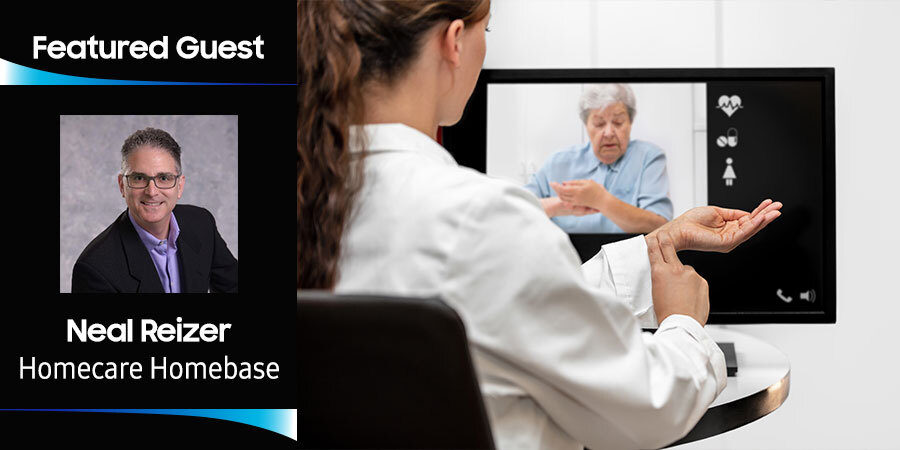Editor’s Note: This conversation is part of our ongoing “Future State Of” series. It has been edited for length and clarity.
The COVID-19 pandemic has had a massive impact on the healthcare industry. One result has been an incredible rise in appreciation for frontline workers, especially nurses. But one aspect that hasn’t received as much attention in the mainstream pandemic conversation is in-home healthcare, which more than 4.5 million Americans receive. The pandemic is showing us how important safe delivery of in-home healthcare is, particularly since many patients who receive it are senior citizens and high-risk. Even as the economy begins to reopen, this patient population will likely stay home longer until a proven treatment or vaccine is available, indicating the demand for in-home care will continue to grow and could have a long-term effect on the culture of healthcare in the U.S.
Taher Behbehani, GM and SVP of Samsung Mobile B2B, along with Andrea Raines from Samsung Mobile B2B, sit down with Neal Reizer, SVP of product management at Homecare Homebase, a leading software solution for home-based care. They discuss how home-based care is adapting to address the pandemic, and how it will continue to drive healthcare delivery in the future.
Taher Behbehani: Hi, Neal. Thanks for speaking with us today. To start, tell us what’s going on with your business and how your business has changed in the past six months given the pandemic and what’s been going on in the marketplace.
Neal Reizer: The business model itself is delivery of care in the home, which is where patients want to be seen because it’s a lower cost venue and you can get tremendous quality outcomes. COVID had a dramatic impact on our customers. Our customers are the ones that are out on the front lines serving the patients, and immediately — almost immediately — what we saw was a dramatic drop in the number of visits made. For two reasons, primarily. One of them is that patients didn’t want anybody in their home — rightly so. And secondly, even those that did want people in their home, you had a lot of clinical staff that had been exposed to COVID that had to quarantine. So for a good month or two, you had the dynamic where a lot of the visits had dropped and there was a real uptake in virtual visits — that really was a mad scramble, to begin to understand how you could supplement in-person physical visits with virtual visits. And then, over the last probably two or three months, I think things have started to level back off. Hospice we’ve seen a little bit less in terms of the rebound. There’s still quite a bit of concern about letting people into these residential facilities where some amount of hospice is practiced.
Andrea Raines: How has this impacted the productivity of your customers? Are they trying to be more efficient during this time when going into homes?
NR: Let’s take COVID out for a second, then I’ll overlay COVID. In a non-COVID world, our application is geared 100 percent toward driving the most efficient, effective workforce that is going into patients’ homes. That’s the way the care is delivered to the overwhelming majority of our customers. There is some in-patient consideration, but almost exclusively, all the work is delivered in a patient’s home under normal circumstances. We’ve been a great partner with Samsung. The devices you bring forward are the ones that these caregivers take into the home and give them that mobility to be able to work in very difficult environments in a home. For example, sometimes they’re in the middle of a city and they can’t get internet. So, your devices, and the ability of our application to work in an offline mode and then synchronize when we get network connectivity again, is a blessing. And the tablets you guys provide are helpful because they could slip into a lab coat or into a satchel and be very inconspicuous, as opposed to a traditional bulky laptop that maybe doesn’t have great battery power or requires a place to put down in a patient’s home, and you can’t always do that. That said, the combination of Samsung and Homecare Homebase, I think, has always driven a high degree of efficiency and effectiveness.
Emerging changes from the pandemic era
See key learnings and statistics from the Future State of Business 2020 survey and report. Read Here
Now you overlay COVID and it’s a whole different set of circumstances. All that effectiveness is still there, but now you’re struggling, right? Because you can’t get in the home anymore in some cases. So, we’ve got customers who are moving some of their visits to virtual. They’re using Zoom or Microsoft Teams, or any number of third-party partners to create these virtual visits, and they’re still using Homecare Homebase. So, the nurse may not necessarily leave their home, but they’re using their Samsung tablet with Homecare Homebase to be able to document that visit just like they would if they were in-person. The only thing that they clearly can’t do are things that require physical, hands-on care, like wound care.
We’ve got other customers that are being creative where they’re doing a hybrid model. The nurse or the therapist will sit in the driveway of the patient’s home and they’ll do a virtual visit in the car. They’ll call the patient using Zoom on the tablet device. They’ll do as much of the visit as they can virtually from their car. Then they’ll go in the home for that final piece of care: change their wounds, take vitals, then get out. So instead of being there for an entire hour, they’re only there for maybe 15, 20 minutes. The mobility of that device gives them tremendous flexibility to be creative in the face of COVID.
AR: What do you think will happen next? Will these virtual visits become more common? Or do you think there’s going to be a rebalance once this is over?
NR: The short answer is it is going to depend. In home health, specifically in the hospice world, there are legislative requirements that prohibit virtual visits from being used as a means for reimbursement. Unlike a telemedicine or a virtual visit that you may have with your primary care physician or with a hospital, where there are mechanisms for reimbursement, those don’t exist in the home health and hospice world. So it’s difficult to make an economic model because there are situations where it is a severe economic penalty for the home health agency to use a virtual visit in place of a physical visit. Even though they’re providing good care, doing the same thing, even perhaps getting the same outcomes, their reimbursement would be substantially different because virtual visits are not reimbursable. So, there are some legislative changes that need to happen. And I think that the climate is good. I think that CMS [Centers for Medicare & Medicaid Services] has been very friendly towards us and has done a nice job of articulating it. But this is a legislative issue, not a regulatory issue, so there has to be some law change to allow us to begin to reimburse for these.
On the other hand, though, I think the genie is out of the bottle, so to speak, in that the acceptability of these virtual visits is higher than it ever has been. So, I think you’ve got two things that are at conflict. You’ve got patients who are seeing that this is a good technology, less burdensome on them, less time-consuming. And then you’ve got to figure out the reimbursement model through some legislation that hopefully will be forthcoming. Then I think it really will be a boon in home health and hospice.
Now that said, I don’t think it will ever be a pure virtual experience. There are going to be patients who are recovering from wounds, or need physical therapy, where you’re going to need somebody to come out and do specific things that require a visit.
TB: So, what’s working and what’s not working from your technology offering point of view?
NR: I think what worked really well is that we didn’t anticipate that the flexibility of the application was going to be so valuable. For example, our customers were able to develop CDC [Centers for Disease Control and Prevention] screening guidelines and reporting dashboards with pretty much off-the-shelf, out-of-the-box capabilities with our products, which was incredibly helpful in managing populations of COVID patients.
What I’ll say was the most challenging thing was that there was so much uncertainty and changing information across the spectrum, which made it really hard for us to know early on what investments to make in the product. And honestly, even the CMS was well-meaning, and I 100 percent support what they did. They relaxed a lot of regulatory constraints and they made some emergency changes and considerations. That was hard for us because we pride ourselves on being a highly compliant system. So when you take an enterprise piece of software that is tuned to ensure that you can comply with federal laws, and all those laws kind of get waived overnight, we did have to scramble a bit to figure out things and very quickly release some changes.
TB: What do you expect to see as we go into the next year?
NR: Telemedicine is going to be important, but I don’t think that’s the major story. When I look out moving forward, what I’m seeing now is an understanding and an acceptance of what care delivered in the home can provide.
What I think you’re going to see is an awareness and an awakening of the role that home health and home hospice can provide, and I think you’re going to see a shift in where patients end up when they get discharged from hospitals or when they get referred from different kinds of events from their providers. And I think that is going to have some interesting ramifications for the cost that’s spent on patients, because all the studies show how care is cheaper in-home than in any other setting.
TB: Thanks Neal, this has been a great conversation. I really appreciate it.
NR: Thank you, Taher.
Discover how Samsung’s digital health solutions are supporting the patient experience in remote care. And keep up to date with the latest announcements and insights by following Taher Behbehani on Twitter.













